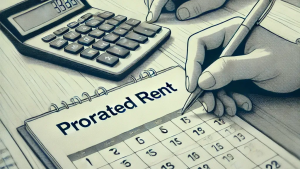Prorated rent is the rent paid by a tenant for the time, duration, or days for which they stayed in a property. It is a useful concept in short-term rentals or when a property is rented between the months. It allows the tenant to avoid overpaying for a property while enabling the landlord to prevent tenant vacancy.
This blog covers the concept of this and enlists everything a landlord and tenant should know about prorated rent. Let’s start with what prorated rent is.
What is Prorated Rent?

It refers to the portion of a full month’s rent that a tenant pays when they occupy a Rental Property for only part of the month. Instead of paying for the entire month, the tenant pays a reduced amount based on how many days they live in the property. This typically occurs when a tenant moves in or out mid-month. To calculate rent, landlords use a simple formula: divide the monthly rent by the number of days in the month, then multiply that daily rate by the number of days the tenant will be occupying the unit.
For example, if the rent is $1,500 per month and the tenant moves in on the 10th day of a 30-day month, the rent would be prorated by calculating the daily rent ($1,500 ÷ 30 = $50 per day) and multiplying it by the remaining days of occupancy (21 days). Therefore, the prorated rent would be $1,050.
Prorated rent is commonly used to ensure fairness for both landlords and tenants. It prevents tenants from paying for days they haven’t occupied the property and allows landlords to avoid losing rental income when a lease starts or ends in the middle of the month.
Let’s see when a landlord or tenant can use prorated rent.
When to Use Prorated Rent?
Prorated rent is generally used when tenants occupy a rental property for only part of a month, ensuring a fair rent calculation. It’s commonly applied during move-ins, move-outs, lease renewals, or when adjustments are needed mid-month. Prorating allows both landlords and tenants to pay only for the days the property is actually occupied, preventing overpayment or income loss. Here are some situations when a landlord or tenant can use prorated rent.
1. Move-ins and Move-outs
When Tenants move out or in of a rental property in between the month, prorated rent is calculated to charge for only the days the property is occupied, ensuring neither party overpays or loses money.
2. Lease Renewals and Breaks
If a lease is renewed or terminated in the middle of the month, prorating the rent ensures that the tenant only pays for the exact days of occupancy within the transition period, accommodating both parties.
3. Mid-month Adjustments
Mid-month rent adjustments may be needed if rent terms or amounts change unexpectedly. Prorating allows rent to be recalculated accurately for the remaining days of the month, ensuring fairness for any changes made.
How Does Prorated Rent Work?

Prorated rent works by calculating the amount a tenant owes when they occupy a rental property for only part of a month, instead of the entire month. It ensures the tenant pays rent only for the days they reside in the property. To determine prorated rent, the landlord divides one month’s rent by the total days in the month. It reflects the rate per day. Then, the rate is multiplied by the total days the tenant will occupy the property.
For example, if the rent is $1,200 per month and a tenant moves in on the 15th day of a 30-day month, the per day rent is $1,200 ÷ 30 = $40. The prorated rent for the remaining 16 days would be $40 × 16 = $640. This method ensures that both the landlord and tenant pay or receive the correct amount, preventing overpayment for the days the tenant doesn’t occupy the unit. Prorated rent is usually applied during move-ins, move-outs, lease renewals, or adjustments to lease terms, ensuring that rent charges are fair and accurate based on occupancy.
Benefits of Prorated Rent to the Landlord
Prorated rent offers several advantages to landlords, ensuring they maximize rental income and maintain positive tenant relationships. By prorating rent, landlords can avoid losing potential income from partial-month occupancy while also offering fairness to tenants. It simplifies move-ins, move-outs, and lease transitions, reducing potential disputes over rent.
Here are some key benefits that prorated rent offers to landlords.
1. Maximizing Income
Prorating rent ensures landlords don’t miss out on income when tenants move in or out mid-month. Instead of leaving units vacant until the start of a new month, landlords can collect rent for the exact days of occupancy.
2. Fairness and Transparency
Prorated rent fosters transparency, as tenants are only charged for the days they occupy the property. This fairness can improve landlord-tenant relationships and reduce disputes over rent calculations.
3. Streamlining Transitions
During Lease Renewals or breaks, prorated rent simplifies the process by accurately calculating rent for partial-month transitions. This ensures both parties have a clear understanding of their financial obligations, minimizing confusion or potential conflicts.
Benefits of Prorated Rent to the Tenants
It provides key benefits to tenants by ensuring they only pay for the days they actually live in the rental property. This approach promotes fairness, making it easier for tenants to manage their budgets. Here are the key benefits prorated rent offered to the tenants.
1. Paying Only for Days Lived
It allows tenants to avoid paying for days when they aren’t occupying the property. This ensures they only pay rent for the specific days of their stay, offering a cost-efficient solution for short-term or mid-month arrangements.
2. Budget-Friendly Transitions
When tenants move in or out mid-month, It reduces the financial burden of paying a full month’s rent. It helps tenants align their payments with their actual move dates, providing a smoother and more affordable transition between homes.
3. Clear Rent Calculations
Prorating rent provides clarity and transparency in billing. Tenants can see a clear breakdown of how their rent is calculated for partial months, reducing the risk of disputes and enhancing trust between landlords and tenants.
Maximize Your Rental Experience: Partner with an Expert to Learn About
This allows a tenant to pay only for the days they occupy the property. At the same time, it allows the landlord to avoid vacancy and rent the property to a trustworthy and reliable tenant. A rent benefits both the landlord and the tenant simultaneously and provides them with the best renting opportunity.
However, to maximize the benefit of prorated rent, the tenant or landlord must know how it works, their options, and how they can secure their best interest using prorated interest. To learn everything about the same, the landlord or tenant can contact Citadel Property Management Corp. and consult with an expert.
Frequently Asked Questions
1. How to calculate prorated rent?
Rent is calculated by dividing one month’s rent by the number of days in the month and multiplying that daily rate by the number of days the tenant occupies the property.
2. Can landlords refuse to prorate rent?
Yes, landlords can refuse to prorate rent unless it’s specified in the lease agreement.
3. How does prorated rent affect lease renewals?
Prorated rent simplifies lease renewals by ensuring tenants pay accurately for partial months during transitions.
4. Should prorated rent be mentioned in the lease agreement?
Yes, it’s a good practice to include terms about prorated rent in the lease agreement to avoid misunderstandings.




